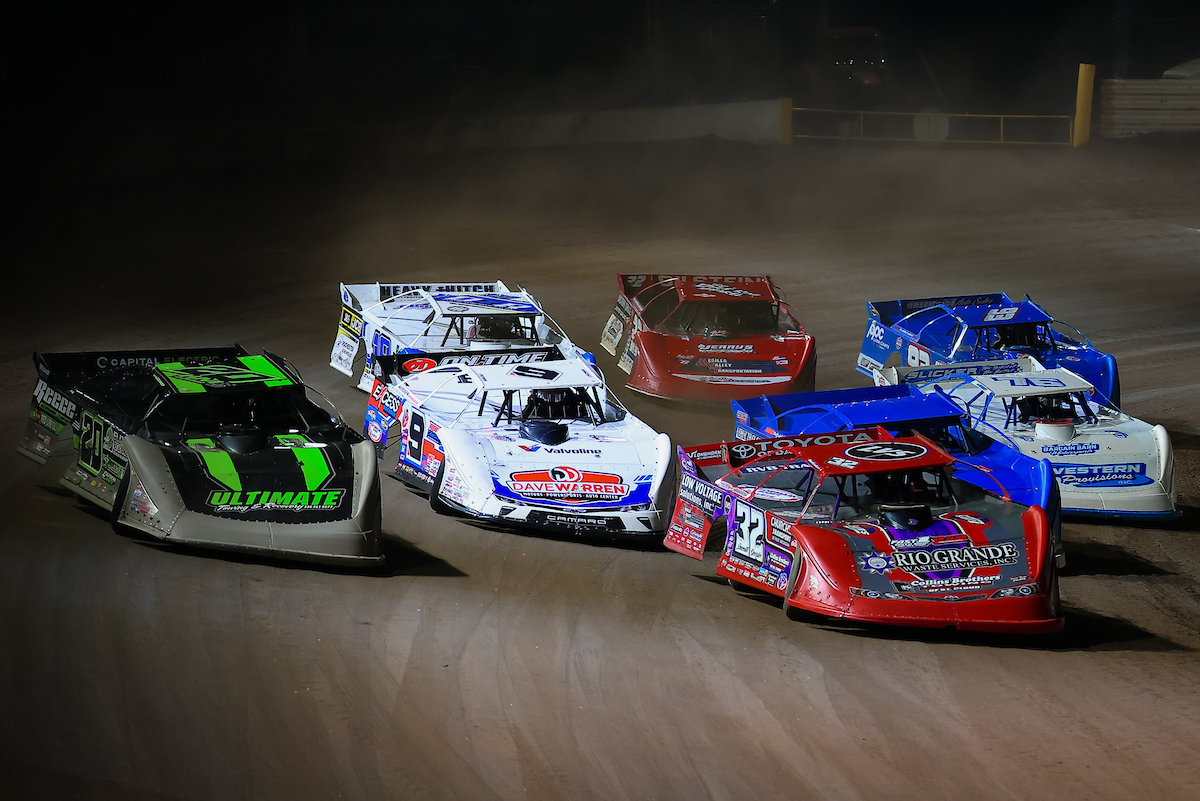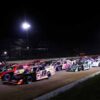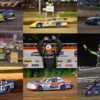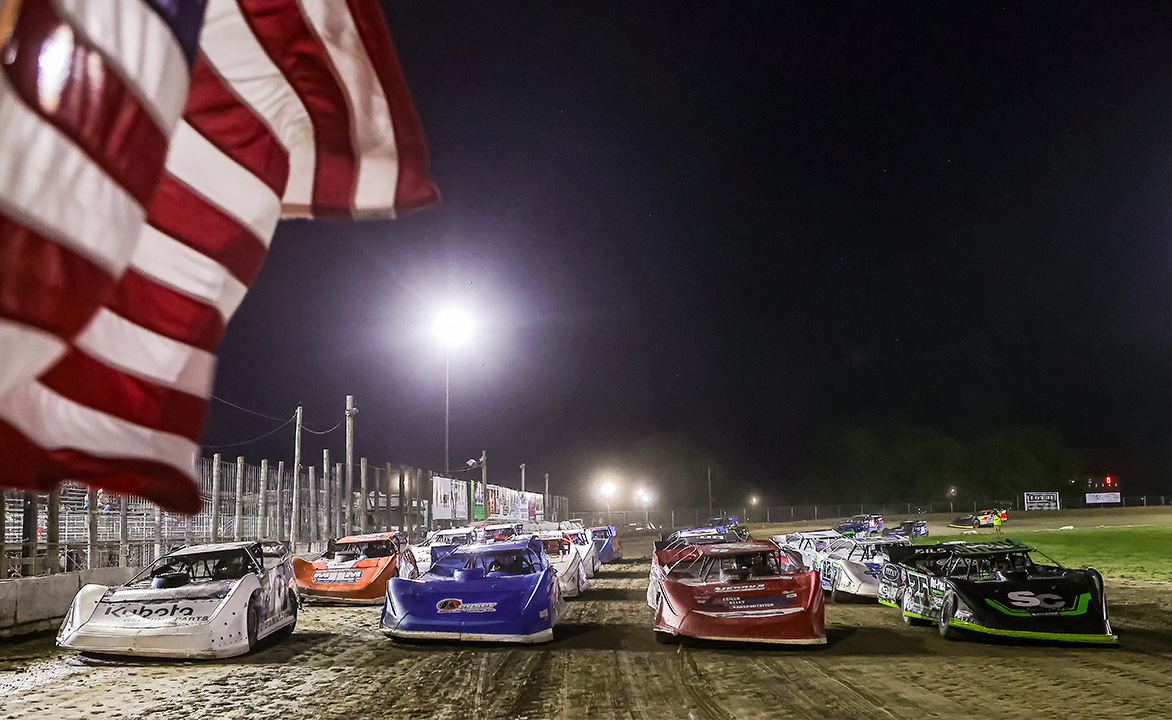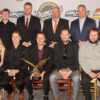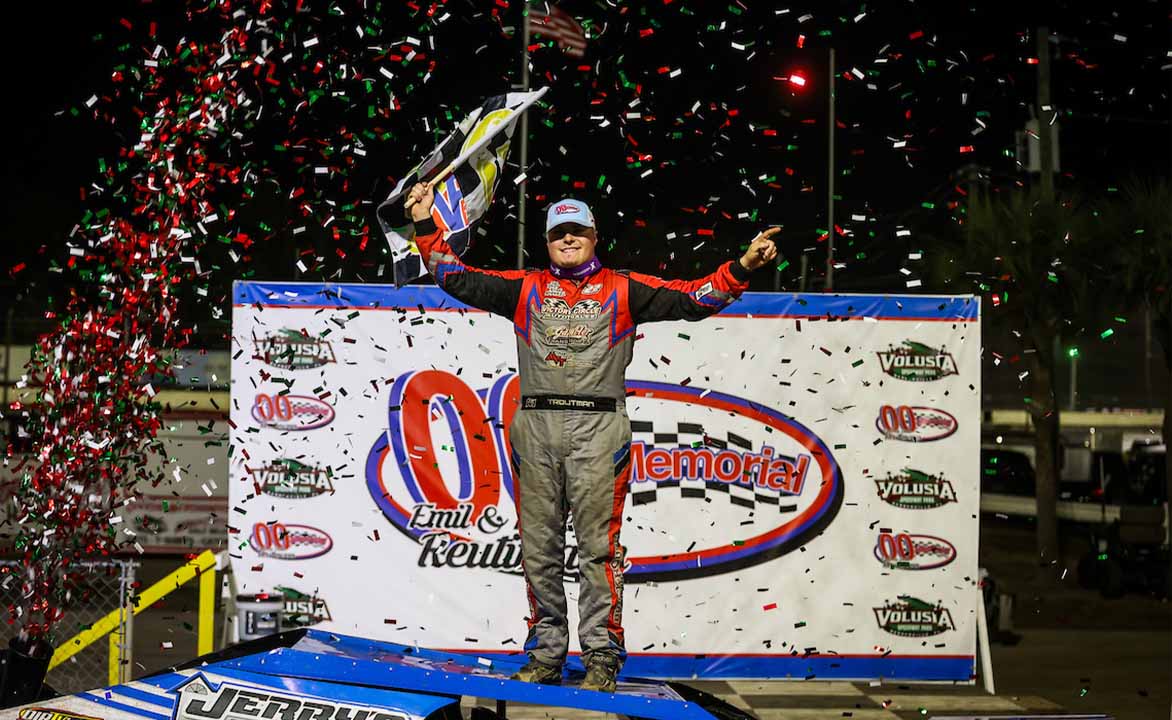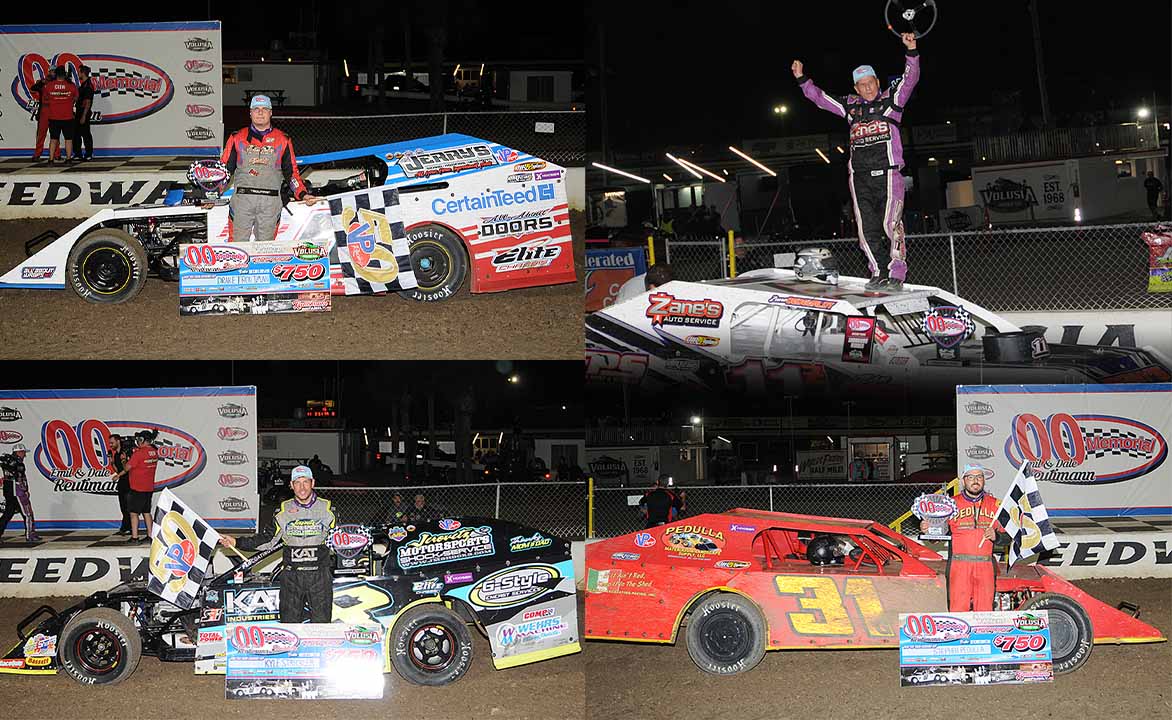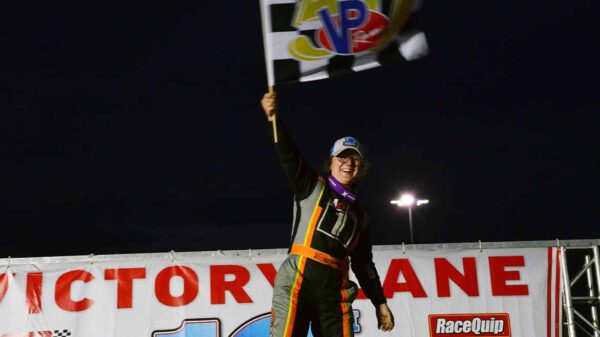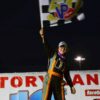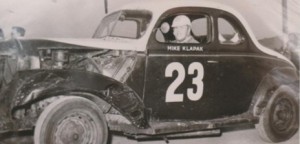
HoF 2009 Mike Klapak 1953
Weedsport, NY — May 9, 2009 – By Walt Wimer, Northeast Modified Hall of Fame Selection Committee
Highly successful Modified-Sportsman veteran and former national points champion Mike Klapak has been named posthumously a 2009 ‘pioneer’ selection for the Northeast Modified Hall of Fame. Driver inductions and special award ceremonies are scheduled for Sunday, May 24 on the Cayuga County Fairgrounds in conjunction with the annual Memorial Day Weekend holiday show at the adjacent speedway.
If it were not for the pioneers of racing back in the early 1950s we most likely would not be enjoying weekly short track action as we do year after year. One of those forerunners was Mike Klapak of Warren, Ohio, who drove his first race in 1931 and later became a star driver of the 1950s. In fact, in 1952, Johnny Lemmo, track announcer at several Ohio/Pennsylvania tracks, wrote a story on Klapak for SPEED AGE magazine titled “Mr. Stock Car.”
Klapak was born in 1913 in Campbell, Ohio, an eastside suburb of Youngstown. Early in life he became interested in motorcycles, but it was a 1931 trip to the Indianapolis 500 that would change his life forever. Before that year was over he and friend Harry Huffman had built an old Ford roadster for all of $90, and Klapak was racing at the nearby Sharon Speedway on the Penn-Ohio border. He raced that car 11 times in two years and won six races, while finishing second in the other five. This was the start of a great racing career that included five national Sportsman championships in NASCAR and MARC (now ARCA) and New Car wins with USAC.
In 1933 he married his wife Lucille and with raising a family, the depression and World War II, his driving career was put on hold for some 13 years. But in 1946 he was racing again, mostly in the midgets that were the rage after the war. Klapak never set the world on fire in the midgets, and then in 1947 a bad crash at the Barberton Speedway left him with a crushed chest and five broken ribs.
Klapak was on the sidelines for two years until 1949 when he caught the bug to try the new Stock Car craze that was beginning to sweep the country. He built a Flathead powered Ford coupe and went racing at the Canfield Fairgrounds Speedway just south of Youngstown. At first he didn’t have a whole lot of luck, but then he took his trusty Ford over to his old stomping grounds at Sharon Speedway and promptly won his first race in a stock car on October 23, 1949.
Canfield became a NASCAR track in 1950, and with a guy able to race almost every night of the week, Klapak gave up his regular job and became a professional race driver. He and Bill Spear built another Ford coupe and went racing….NASCAR style. By mid-season Klapak was doing so well that he felt they could go for the national points title. The race for the NASCAR Sportsman title came right down to the wire with Klapak just edging out famed midget racer Roscoe “Pappy” Hough. And he did it in Hough’s backyard as the final race was at a track in New Jersey with Klapak winning by the narrow margin of 11 points.
In 1951 Klapak did it again, but this time he had to beat arch-rival Dick Linder of Pittsburgh, who he raced against several times a week. It was often Klapak in his #23 and Linder in the famed Palone Brothers yellow #V-2 finishing 1-2 on both sides of the state line. But this time the points were not nearly as close with Klapak winning by almost 600 markers. And Linder almost didn’t get second as he only topped Mike Little, the “Old Fox” of Johnstown, PA, by just three points. For his second title Klapak earned $1,000 in point money, not bad in 1951.
Come 1952 Klapak pulled off the Hat Trick, winning the NASCAR title for the third straight year. And once again it was the trio of Klapak, Linder and Little who kept the Penn-Ohio fans on the edge of their seats all season long. It was a bit closer this time with Linder, but Little was a ways back in third. 1952 was the high point of NASCAR racing in the Penn-Ohio area, a time when a driver could race seven times a week, Tuesday through Saturday and twice on Sunday. No wonder drivers from the border line battleground earned 16 of the top 20 spots in the final NASCAR points that year and swept the first ten.
Big changes came over the winter of 1952-53. John Marcum, who had been the top NASCAR official in the area for three years, broke with Bill France and started his own circuit, the Midwest Association for Race Cars (MARC) — which today is ARCA. Marcum took most of the better tracks with him along with the best known drivers. NASCAR fought back by adding some new tracks to its roster but would never again control Penn-Ohio racing.
The change in sanctioning bodies didn’t bother Klapak too much, as he was still the champ for the fourth straight time. But he did have a scary crash that year at the Pinegrove Speedway in Shippenville, PA. The race was part of a Labor Day doubleheader with Pinegrove in the afternoon and Butler (PA) at night. During the Pinegrove feature Klapak’s black #23 “Bambi Special” went down over a first turn embankment with the Ford coupe flattened like a pancake. Like his 1947 midget crash, Klapak suffered chest injuries and broken ribs. He did not make the Butler race that night but was back racing soon enough to win the points title.
And if four times weren’t enough, Klapak did it again in 1954, his last year running Sportsman cars on a regular basis. Both MARC titles ended with Bob James, a “hall of fame” driver in his own right, finishing in the runner-up position. James beat Klapak for the Sportsman Park title, but Klapak won the Canfield crown over Bill Forney and the overall MARC circuit points championship.
Racing was quite different back then, and today’s drivers can hardly imagine running six and seven times a week like the point leaders of the early 1950s. For example, in 1952 Linder ran 152 feature races while Klapak ran 144. Linder, the big winner of the day, won 51 times while Klapak won 20. However, Klapak had almost twice as many seconds as wins, piled up the points, and beat Linder for the second straight year. During his five-year reign as points king, Klapak won 102 races for an average of just over 20 per year. The costs of a racecar were also quite different then. For example Klapak’s championship entry in 1954 was worth around $1,500.
Come 1955, Klapak elected not to defend his five Sportsman titles. Rather than the weekly grind with the old coupes he headed off to the MARC “New Cars” shows which were the equivalent of NASCAR’s Grand National circuit that became today’s “Cup” cars. The car Klapak drove that year was a very unlikely racer, a 1955 Cadillac!! John Marcum himself bought the car direct from the factory for Klapak to drive. The car, with Klapak’s well-known number 23 on the sides, had the power but was too heavy and only finished one race. But by 1956 Klapak was back in a Ford and had gotten the handle on the newer larger cars.
Along the line Klapak switched over from MARC to USAC where he drove a brand new Ford given him by the Ford Motor Company. In that Ford he won one of the biggest races of his career, a 500-miler at Trenton under USAC sanction. Then in 1958 and ‘59 he won a pair of 250-mile races at Langhorne. Those three big wins proved Klapak felt at home on the big tracks as much as on the small bullrings, with the Trenton victory showing he could master pavement as well as the dirt. He finished fourth in the 1957 USAC points, won by Jerry Unser of the famed New Mexico racing family, then in both 1958 and ‘59 he was runner-up to Fred Lorenzen, who would later be NASCAR’s “Golden Boy” of the sixties.
As a new decade moved in Klapak, now well up in his forties, began to cut back a bit. He stuck with the new cars, racing with both MARC & USAC. In August of 1960 he finished sixth in a USAC race at Milwaukee and then six days later was third on the dirt at Eldora in a MARC race behind all time MARC/ARCA great Iggy Katona. “Late Models” had replaced the coupes at many weekly tracks by the early 1960s, and Klapak gave them a whirl from time to time, like in a 60-lapper at Ohio’s Lorain County Speedway, where he finished second to his old Sportsman rival Bob James in August of 1961.
Klapak continued to run the new cars with MARC in 1963 with several good finishes and a 12th in the points. 1964 was his final year. He started off the season running the first ARCA race at Daytona International Speedway in a peach colored #9 Ford owned by New York car dealer Julian Buesink. He was running third late in the race when his car ran out of fuel. By the time he stopped the race was over, and he was credited with an eighth-place finish.
At age 51, Klapak finished out his career with some good runs at his old stomping grounds, the Sharon Speedway, in the later part of 1964. He was second in a 100-lapper in August of that year and then second in a weekly show September 6. The curtain came down September 20, 1964 on a very memorable career when he finished third in a 50-lapper that brought an end to Sharon’s season and Klapak’s career.
Mike Klapak enjoyed a long retirement before passing away in March of 1997 at the age of 84. Certainly one of the pioneers of the sport, he is gone now but “Mr. Stock Car” will long be remembered.
Sources:
“Mr. Stock Car” by Johnny Lemmo, SPEED AGE Magazine December 1952;
“The Original Mr. Stock Car”, by Diz Dean, TRI-STATE AUTO RACING NEWS July 5 and 12, 1991 (with permission of the author);
Various speedway programs and yearbooks from NASCAR, MARC, ARCA and USAC;
Old newspaper clippings and the author’s personal memories.
Special Thanks:
Diz Dean, Dave Burt, John Stasiak, Gary London, Pat Greer and Ron Pollack.
DIRTcar Racing Northeast main office is located in Weedsport, New York on the Cayuga County Fairgrounds www.cayugacountyfairspeedway.com, home of the 2009 DIRTcar All-Star Weekend, July 17-19, featuring Hoosier Tire-VP Racing Fuels Mr. DIRTcar Championship Series events for Sportsman and Big-Block Modifieds in the richest short-track show of its kind in the nation — the $20,000-to-win Advance Auto Parts Super DIRTcar Series “DIRTcar All-Star 100” on Sunday, July 19.
Headquartered in Roanoke, Va., Advance Auto Parts, a leading automotive aftermarket retailer of parts, accessories, batteries, and maintenance items in the United States, serves both the do-it-yourself and professional installer markets As of April 19, 2008, the Company operated 3,291 stores in 40 states, Puerto Rico, and the Virgin Islands. Additional information about the Company, employment opportunities, customer services, and on-line shopping for parts and accessories can be found on the Company’s web site at www.advanceautoparts.com.
The Advance Auto Parts Super DIRTcar Series for Big-Block Modifieds is brought to fans across the Northeast by several sponsors and partners, including series sponsors Advance Auto Parts, Hoosier Racing Tire www.hoosiertire.com and VP Racing Fuels www.vpracingfuels.com. Promotional partners include Rite Aid Corporation www.riteaid.com, Dig Safely New York www.digsafelynewyork.com and the University of Northwestern Ohio www.unoh.com and the contingency sponsors are Bars Leaks www.barsproducts.com, Bert Transmission www.berttransmission.com, Bicknell Racing Products www.bicknellracingproducts.com, Bilstein Shocks www.bilstein.com, Brodix Cylinder Heads www.brodix.com, Ferris Industries www.ferrisindustries.com, Integra Shocks www.integrashocksandsprings.com, Intercomp www.intercomp-racing.com, KSE Racing Products www.kse-racing.com, Motorsports Safety Systems www.motorsportssafetysystems.com, Penske Shocks, www.penskeshocks.com, Racing Electronics www.racingelectronics.com, Rislone Oil Stabilizer www.barsproducts.com and Wrisco Industries www.wrisco.com.


